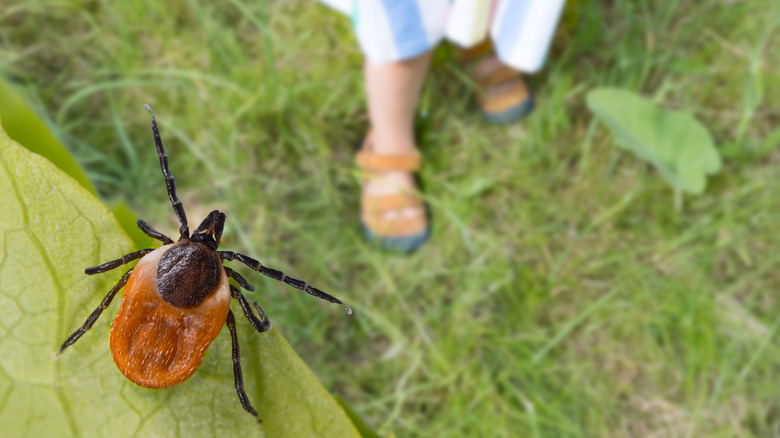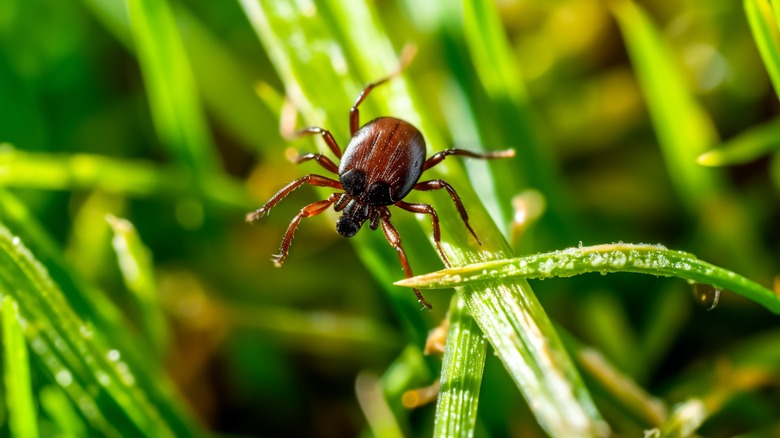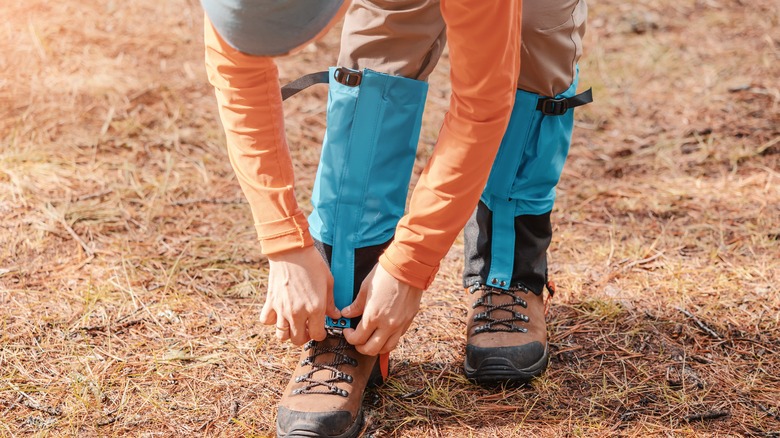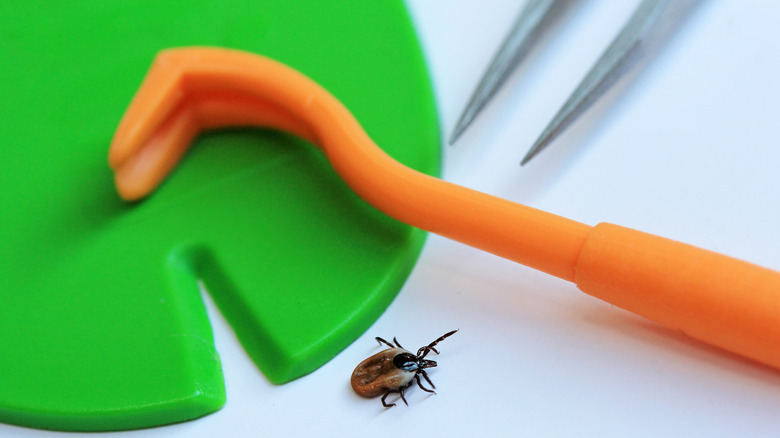Stop Worrying About Ticks On Your Hike With These Clever Tips
There are myriad health benefits to hiking –- better balance, improved mood, increased strength, and a boost in heart health are only a few of the pros of getting active in the great outdoors. And with 400 beautiful national parks to explore in the U.S., there are plenty of opportunities for a fun adventure on the trails. Speaking of adventure, a species of blood-sucking pest could derail your enjoyment — ticks. Whether you're planning to scramble along the Rocky Mountains, trek along the Gulf Coast, or trudge through Acadia National Park, you're likely to encounter a tick (or many) during a spring, summer, or fall hike -– they love warm, moist areas but many varieties become dormant during winter.
Don't panic! While these eek-inducing bugs are here to stay, there are plenty of ways to stop them from climbing aboard when you least expect it. From using strong insect repellents to wearing appropriate tick-resistant clothing and choosing the best place to walk, we have assembled plenty of great ways to help prevent a tick bite. And we found them all by sifting through a ton of research released by experts at large government and health agencies like the Centers for Disease Control and Prevention (CDC). Finally, with these clever tips, you can stop worrying about ticks on your hike!
Why are ticks bad?
A variety of tick species (around 100, in fact) are found throughout the United States; you'll even see them in Hawaii. From the American dog ticks that live east of the Rocky Mountains (and a few areas in the Pacific) to the Rocky Mountain wood ticks that hunker down in the Rocky Mountain states to the blacklegged ticks in the eastern U.S. to the brown dog ticks that are found nationwide, there are quite a few of these creepy crawlies hanging around. The good news? According to the CDC, not all ticks will bite humans, and even fewer will infect people with disease-causing bacteria, parasites, viruses, or pathogens. However, ticks that pass an illness to their hosts can cause serious symptoms.
Two of the most common tick-borne diseases in the United States are Lyme disease and Rocky Mountain Spotted Fever. The former is carried by the blacklegged tick prevalent in the northeast states and upper Midwest, with some also living on the Pacific Coast. Symptoms include a rash (often in the shape of a bullseye), fever, headache, and fatigue. If the disease isn't treated, the symptoms can become much more severe and possibly spread to the heart and nervous system. Rocky Mountain Spotted Fever has similar effects, which include a headache, rash, and fever. If left untreated during the early stages, this disease can lead to amputation of an extremity. In the worst-case scenario, this illness can become fatal.
Know where they live
As the famous saying goes, "Knowledge is power." In this case, knowing where ticks hunker down is the key to avoiding a bite. We now know that ticks can be found across the United States, but they are also prevalent in many countries worldwide –- tick-borne encephalitis has been transmitted from ticks to humans in East and Central Asia and Europe, for instance. That's why it's so important to be aware of your surroundings and these icky critters' most beloved hiding spots. Ticks feel most at home in wooded areas and like to cling to long grasses and shrubs.
Ticks can also be found in your lawn and leaf piles, or leaf litter, as many refer to those old layers of leaves decomposing on the soil. Ticks also like to hitch a ride on animals that happen to brush past their homes. These insects can feed on mammals, reptiles, birds, and even amphibians. According to the CDC, ticks can sense an animal's body odor, heat, breath, and vibrations. They wait on the tips of grasses and shrubs for an opportune moment to climb onto their next host. If you're hiking between April and September, be extra vigilant, as this is when ticks are most active in many parts of the U.S. They love warm and humid conditions.
Use a strong insect repellent
Don't mess around when it comes to insect repellent! The CDC advises choosing a product with strong ingredients like DEET, IR3535, picaridin, para-menthane-diol (PMD), or oil of lemon eucalyptus. It should be registered with the Environmental Protection Agency (EPA) to ensure it is safe. Not sure how to tell? Check out the EPA's online repellent search tool to help determine the best product for your plans. The results will differ depending on the length of time you'll be out and which insects you'd like to repel (i.e., ticks alone or do you want to add mosquitos?). Once you've chosen the repellent, follow the directions closely. Also, do not use lemon eucalyptus oil or para-methane-diol-containing products on kids under 3.
The CDC recommends pre-treating clothes, camping and hiking gear to increase protection. It suggests using a product with 0.5% permethrin, which can stay potent through multiple washes. According to an article published by The University of Rhode Island, commercially treated clothes (i.e., those sold by Insect Shield) can stay protected for 70 washes. The same article advises hikers to use permethrin instead of DEET-containing products on their clothes, as this ingredient "kills ticks on contact" and lasts longer. Save the DEET products for your skin, and remember to reapply.
Dress in white or light colors
Ticks love to hang out in long grasses, clinging to the blade's tip with only their third and fourth pairs of legs. According to the CDC, they then stretch their first pair of legs to climb onto their next, unsuspecting host. Eww! If you don't want this to be you, be cautious of what you wear on your hike. Many experts advise choosing white or light-colored clothes so you can spot ticks before they make their way to your skin. Many ticks are tiny and hard to see, so light clothes make them easier to identify.
Even the American Hiking Society claims that lighter-colored clothes may attract fewer ticks. However, a small study (there were only 10 participants) published in the Scandinavian Journal of Infectious Diseases found the opposite, concluding that dark-colored clothing appealed to fewer ticks. Regardless of who is correct, it's clear that wearing lighter colors makes it easier to see creepy crawlies of all kinds. If you choose to go the darker clothing route, be extra vigilant when checking, as the ticks are more likely to be camouflaged.
Wear clothes that resist ticks
While we're on the subject of clothes, choosing the best tick-resistant attire is essential. Long pants and long-sleeved shirts will help protect your skin from bites. As mentioned earlier, ticks aren't gymnasts. They don't jump or fly but love to crawl. If you have any exposed skin (like an ankle), they'll head there and climb to a warm, moist spot (think armpit, hair, and groin). Yuck! Make yourself uninhabitable by tucking long pants into your socks. You may not want to wander along New York City's trendy SoHo neighborhood in this getup, but out in the woods, you'll fit right in. Plus, you'll make yourself less attractive to ticks, and that's a look all hikers should be going for!
Next up, tuck your long-sleeved shirt into the waist of your pants. No little critters will be able to get in there once you've eliminated access to skin. Finally, add a pair of tall, rubber boots or leather hiking boots. The more of you that's covered, the less likely you will arrive home with a stowaway. Bonus points if you pre-treat your clothes with permethrin to make them tick-repellent.
Protect your head
While we all know that ticks enjoy hiding in long grasses, they can also be found on trees and shrubs. That means your hair can be an easy vessel if a tick happens to be nearby when your wavy locks are flowing in the breeze. Don't have much hair to worry about? Ticks can still climb on your scalp if you happen to brush up against their resting place. And if a tick happens to hop on via an exposed ankle or arm, it'll be able to make its way pretty much anywhere it wants, including your scalp.
Wearing a hat, bandana, or other head covering can help protect your scalp and hair from unwanted visitors. Another good piece of advice: tie your long hair back. While ticks won't be dropping from the trees any time soon (they prefer to stay low, where they can climb onto hosts like mice or chipmunks), it's always better to be prepared and make your hair and head uninviting in case they're tempted to bite in that area.
Watch where you're walking
Since ticks tend to live in long vegetation and wooded areas, it's best to steer clear of these areas while walking. Instead, stick to the center of hiking trails to limit your exposure to tick territories. If you walk on the side of a path, you'll be more likely to brush against a shrub or tall grasses, which could be filled with ticks lying in wait for the perfect host — you! Can't resist that uncharted trail through the forest? Yes, it might be exciting to embark on an off-path adventure, but you'll be putting yourself at risk for potential tick cling-on.
For those of you keen to leave no trace while hiking, sticking to the middle of a path will prevent damage to vegetation or organisms that live off to the side. You won't be at risk of scarring the terrain if you stay in the center of a designated trail. When it's time for a break, choose your resting place wisely. Don't sit in the middle of an overgrown meadow with grasses that may be writhing with multi-legged creatures. Instead, sit on a large rock or log in the middle of a clearing or another more barren area to eliminate your risk of getting bitten. Also, avoid leaning against a tree. Once you get up to resume your hike, check to make sure you don't have any tiny hangers-on.
Be vigilant while camping
Be cautious of your surroundings if you're hiking during a camping trip, especially a solo camping trip. When setting up camp, choose an open area away from vegetation. You're basically asking for critters to share your sleeping bag if you pitch a tent in a field blanketed in long grass. While staying away from tick-favored spots doesn't mean they won't travel to your "safe" space (remember, they like to hitch rides on creatures like mice, chipmunks, and deer), carefully picking your campsite can reduce your risk of a bite.
Another way to limit a tick's impact in your tent or RV is by treating your camping equipment with permethrin (that heavy-duty insect repellent we mentioned earlier). Camping experts at Section Hiker suggest spraying the inside of a tent and the insect netting instead of the rainfly when using permethrin. The outer section and fly are waterproof, which will prevent the repellent from soaking into the fabric. Plus, they say, the sun's UV rays can break down the permethrin quickly. For another level of protection, be sure to inspect your camping gear and clothing before heading out for a hike — you don't want a tiny, blood-sucking hitchhiker to join your journey.
Put clothes in the dryer
According to an interview conducted with associate professor Jean Tsao and published on Michigan State University's MSUToday website, hikers should place their clothes in a dryer immediately after returning home. She said that 10 minutes on high heat is enough to kill ticks. A study published in the journal Ticks and Tickborne Diseases confirmed this information. Researchers found that just six minutes of drying tick-infested clothes on a high setting was enough to kill ticks.
While washing your clothes in hot water might seem like another effective way to kill ticks, it isn't. Research conducted by the U.S. Department of Agriculture found that lone star and deer ticks can survive a trip through the washing machine in hot and cold settings. When the entomologist in charge of the research placed the studied ticks in the dryer for an hour on high heat, they all died. Don't get too excited yet. Over half of the lone star ticks the entomologist put in the dryer on a "No Heat" setting survived the experience. One-third of the deer ticks tumbled around the heatless dryer also lived. The takeaway? Throw your clothes (and whatever gear you can) into the dryer for at least six minutes, or better yet, 10, on high heat to kill any ticks clinging to them.
Take a shower
After you've put your clothes in the dryer, head to the shower. In her interview with MSUToday, Professor Tsao recommended that hikers check themselves for ticks in a shower within two hours of their walk. This advice is echoed by the Forest Service of the U.S. Department of Agriculture, which advises people to "bathe or shower as soon as possible after coming indoors (preferably within 2 hours)." Doing so could wash off ticks that haven't yet attached and help hikers discover others that may have begun to embed themselves in their skin.
The CDC gives the same advice about showering, stating that it can reduce a person's risk of contracting Lyme disease and other tick-borne diseases. It also says showering gives hikers an ideal opportunity to conduct a thorough tick check. If you find a tick, the New Jersey Department of Health (pdf) advises you to use a tissue to grab it, as long as it isn't attached. If the tick has already embedded itself or part of itself, you'll need to remove it immediately.
Check yourself (and your pets)
As mentioned above, one of the best places to check yourself for ticks is in the shower. The CDC recommends using a mirror (full-length or smaller) to check everywhere (especially your "bits"). A few of ticks' favorite places to embed themselves include the hair and scalp, in and around the ears (including inside that warm, foldy bit near the top), armpits, groin, between the legs, around the waist, inside the bellybutton, and behind the knees. Other places to examine are between your toes, around your chest, and on your back.
Not sure what to look for? Some ticks are super tiny and tough to spot, especially if you have dark hair on your arms, legs, torso, or back. Look very closely for a dark spot or bump. A nymph can be as small as just over 1 mm, while a well-fed adult female tick can measure up to 1 cm. Next, it's time to check your pet. Rub your hands along their fur, feeling for small bumps. According to the CDC (pdf), popular spots for tick bites on animals include the ears (inside and around them), under the collar, on or near the eyelids, on or around the tail, between and under the legs (front and back), and between the toes.
Tips for removing a tick
If you're an avid hiker or simply love to camp, it's probably time to invest in a tick-removing tool. These are usually quite cheap (about $5 or less) and have a small notch in one end to slip around the tick. Once the tick is inside the notch, carefully pull the device in the opposite direction, keeping it flush against the skin. This prevents squishing and removes the entire tick, so there's less risk of infection. Fine tweezers will work just as well. On its website, the CDC recommends gripping the tick as close to the skin as possible with the tweezers. Then, pull up with "steady, even pressure." It says not to jerk or twist the tick, which can cause the mouth to break off and stay inside.
Do not squish the tick in your fingers, burn it, or put products like petroleum jelly or nail polish on it. This can cause the tick to release saliva into the skin. After removing it, clean your hands and the bite with soap and water or rubbing alcohol. Put the tick in rubbing alcohol, wrap it in tape, place it in a sealed bag or container, or flush it down the toilet. If you're worried that an illness has been transmitted, save the tick (in the bag) and bring it to a doctor or mail it to a tick-testing facility to be checked. See a doctor if you develop any symptoms.












